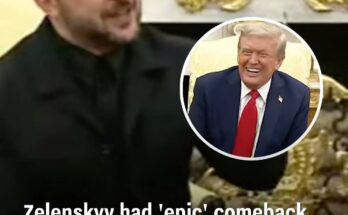A spokesperson from Amazon has responded to reports about the company’s alleged plan concerning its products and Trump tariffs.
During a recent press briefing, White House Press Secretary Karoline Leavitt made strong statements about Amazon’s alleged decision to showcase the Trump administration’s tariff costs on item pages. However, not only has a spokesperson from the e-commerce company set the record straight, but U.S. President Donald Trump praised Amazon founder Jeff Bezos for how he rectified the issue.

White House Press Secretary Karoline Leavitt addressing reporters during a press briefing in Washington, D.C., on April 29, 2025. | Source: Getty Images
Standing beside U.S. Treasury Secretary Scott Bessent, Leavitt did not mince words when addressing the controversy. Responding to a reporter’s question about the company’s rumored plan, she labeled the move as nothing short of “a hostile and political act by Amazon.”
She questioned the company’s timing and motives, rhetorically asking why similar actions weren’t considered under the Joe Biden administration.

U.S. Treasury Secretary Scott Bessent standing beside Karoline Leavitt as she talks about Amazon’s alleged plan. | Source: YouTube/Forbes Breaking News
“Why didn’t Amazon do this when the Biden administration hiked inflation to the highest level in 40 years?” she posed sharply.
Holding up a printed Reuters article featuring Bezos, Leavitt further stated, “As Reuters recently wrote, ‘Amazon has partnered with a Chinese propaganda arm.'” She then reinforced the administration’s ongoing calls for domestic production.

Karoline Leavitt holding up a paper showing a Reuters article excerpt about Jeff Bezos and Amazon. | Source: Getty Images
The moment grew more charged when a reporter pivoted to question whether Bezos, who notably showed public support for Trump by attending his inauguration, remains an ally to the president.

Jeff Bezos standing with Mark Zuckerberg, Lauren Sanchez, and Sundar Pichai at U.S. President Donald Trump’s inauguration in Washington, D.C., on January 20, 2025. | Source: Getty Images
Leavitt sidestepped the inquiry, responding, “Uh, look, I will not speak to the president’s relationships with Jeff Bezos, but I will tell you that this is certainly a hostile and political action by Amazon.”
In the wake of Leavitt’s pointed remarks and news reports on the matter, Amazon was quick to issue a clarifying statement, pushing back on the mounting speculation. Less than two hours after the press briefing concluded, a spokesperson for the retail giant spoke to Consumer News and Business Channel (CNBC), addressing the controversy directly.

Karoline Leavitt addressing reporters about Amazon. | Source: Getty Images
According to the representative, the idea of displaying import charges linked to tariffs had only been a consideration, and only for a very specific corner of the company — its budget-focused shopping section.
“The team that runs our ultra low cost [sic] Amazon Haul store considered the idea of listing import charges on certain products,” noted the company. However, they were careful to emphasize that this concept was never intended for the broader Amazon storefront.

A photo of the Amazon logo on a smartphone, picture taken in Chongqing, China on April 26, 2025. | Source: Getty Images
“This was never a consideration for the main Amazon site,” they added, making it clear that no such changes have been implemented “on any Amazon properties.”
The message they penned on X is equally definitive, as they wrote, “This was never approved and is not going to happen.”
While speaking to reporters about the situation and Amazon’s response on Tuesday afternoon, April 29, 2025, Trump praised Bezos for his swift handling of the matter. He remarked that the billionaire entrepreneur had done “the right thing.”
According to a pool report, Trump went on to describe Bezos as “very nice” and “terrific,” adding, “He solved the problem very quickly […] Good guy.” Such information was published by The Washington Post, which Bezos owns.

Lauren Sanchez, Jeff Bezos, Sundar Pichai, and Elon Musk at Donald Trump’s inauguration. | Source: Getty Images
According to a source familiar with the matter, the tariff detail would appear directly alongside the total listed price, offering a breakdown of what portion was attributed to import fees. Reportedly, this move was motivated by the company’s desire to avoid being blamed for the broader economic consequences of the administration’s trade policies.

Jeff Bezos at the 11th Breakthrough Prize Ceremony in Santa Monica, California on April 5, 2025. | Source: Getty Images
Amazon’s rumored plan and Leavitt’s assertions about such come weeks after Trump announced a sweeping 90-day pause on the reciprocal tariffs affecting dozens of countries, with one major exception — China.

U.S. President Donald Trump signs executive orders in the Oval Office in Washington, DC., on January 20, 2025. | Source: Getty Images
Trump has been particularly steadfast in his belief that high tariffs are a cornerstone of U.S. economic policy. Hence, the announcement, which came late Wednesday, April 9, via the president’s Truth Social account, was unexpected.
In his post, he detailed a tariff pause and why. According to the post, countries with reciprocal tariffs at midnight will now see those duties reduced to a universal 10% rate for the next three months.

President Donald Trump signs executive orders in the Oval Office in Washington, DC. | Source: Getty Images
Trump cited ongoing outreach from over 75 nations, which he said had contacted U.S. agencies, including the Departments of Commerce and Treasury, as a major reason for the pause.
He noted that these countries had not retaliated against U.S. measures, based on what he described as his “strong suggestion.”

Screens showing surging stock shares at the Taiwan Stock Exchange office following Donald Trump’s surprise decision to pause the global tariffs, in Taipei, Taiwan on April 10, 2025. | Source: Getty Images
“This is a window for real negotiations,” Trump said in his statement, pointing to continued talks surrounding trade, trade barriers, tariffs, currency manipulation, and non-monetary tariffs.
However, the softening does not apply to China. Trump doubled down on his hardline approach to the world’s second-largest economy, announcing an increase in tariffs from 104% to 125%, effective immediately.

Construction workers leave a work site in the Central Business District in Beijing, China on April 10, 2025. | Source: Getty Images
He cited Beijing’s recent retaliatory tariffs and what he called a “lack of respect” for global markets as justification for the hike. “At some point, hopefully in the near future, China will realize that the days of ripping off the U.S.A., and other Countries, is no longer sustainable or acceptable,” Trump wrote.
The tariff announcement represents a balancing act, offering temporary relief to many trade partners while escalating pressure on China. With the global economy watching closely, Trump’s strategy appears aimed at resetting the playing field without fully backing off from his aggressive trade agenda.
As the 90-day countdown continues, attention is now focused on whether global leaders will use the window to reach more stable trade agreements or whether the pause is simply a brief intermission in a larger tariff standoff. Either way, Trump’s message is clear, and concessions may be made, but not to China.
The lead-up to this dramatic pause began on April 2, when Trump shocked allies and markets alike with an announcement in the Rose Garden. He declared a national economic emergency and laid out a sweeping new tariff policy to overhaul decades of U.S. trade relations.
The president announced sharp new tariffs on nearly all major trading partners, including a 34% tax on Chinese imports and a 20% tariff on goods from the European Union. A universal 10% baseline was also imposed on imports from every country unless otherwise specified.

In this photo illustration, portraits of Donald Trump and Chinese President Xi Jinping are displayed on a computer screen as the U.S. and Chinese flags are also seen in the background, photo taken in Ankara, Turkiye on April 10, 2025. | Source: Getty Images
In justifying the move, Trump said the tariffs were necessary to protect American workers and industries from what he described as decades of exploitation under a broken global trade system.
He argued that other nations had long taken advantage of the U.S., stating that America had been “looted, pillaged, […] and plundered” economically. The tariffs, he claimed, would bring back factory jobs, generate hundreds of billions in revenue, and restore fairness to global commerce.

Donald Trump announces a plan for tariffs on imported goods during an event in the Rose Garden at the White House in Washington, D.C., on April 2, 2025. | Source: Getty Images
The announcement marked a dramatic escalation in Trump’s trade agenda, and his rhetoric signaled little interest in compromise. Acting under the 1977 International Emergency Economic Powers Act, the president bypassed Congress to fulfill a key campaign promise, but the consequences were immediate.
Stock market futures plunged overnight amid fears of an economic slowdown, and critics warned of rising consumer costs on everyday goods like housing, cars, and clothing.

Market numbers are displayed at the New York Stock Exchange during morning trading in New York City on April 10, 2025. | Source: Getty Images
While Trump cast the tariffs as a patriotic duty and an overdue correction to global imbalances, the move drew skepticism from several corners of his own party.
Republican lawmakers from agricultural and border states raised concerns about retaliation and the impact on American exports, especially with allies caught in the crossfire. Still, Trump remained firm, insisting the U.S. had been “ripped off” for more than half a century and that his administration was finally putting an end to it.

Donald Trump holds a chart as he announces a plan for tariffs on imported goods. | Source: Getty Images
But now, he appears to have changed course. Known for his abrupt pivots, the 90-day pause may prove to be just that, a temporary breather rather than a lasting shift. For now, it’s a wait-and-see moment on whether this easing will hold or if it’s simply the calm before another storm.


